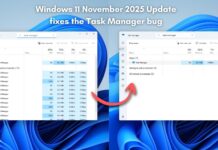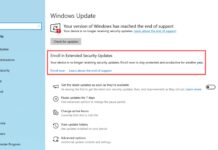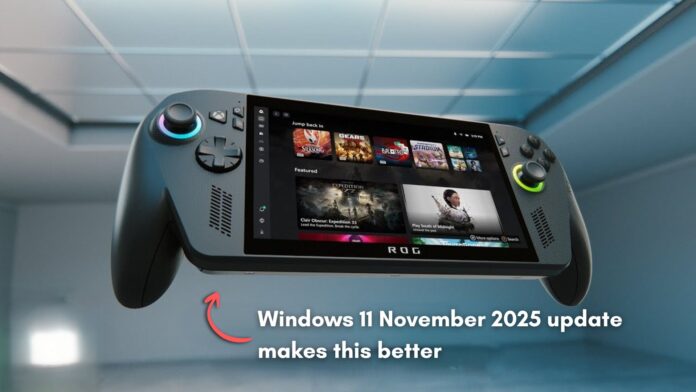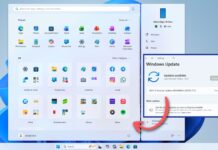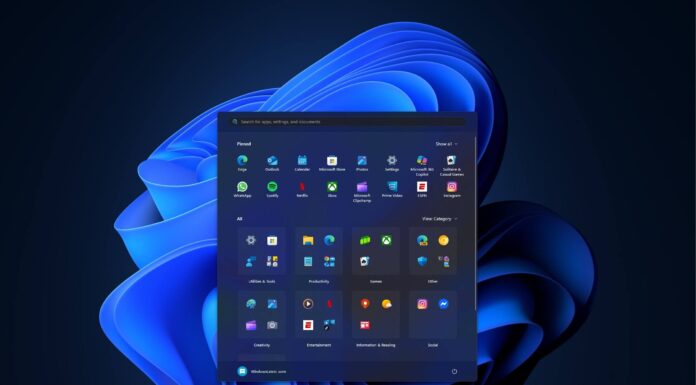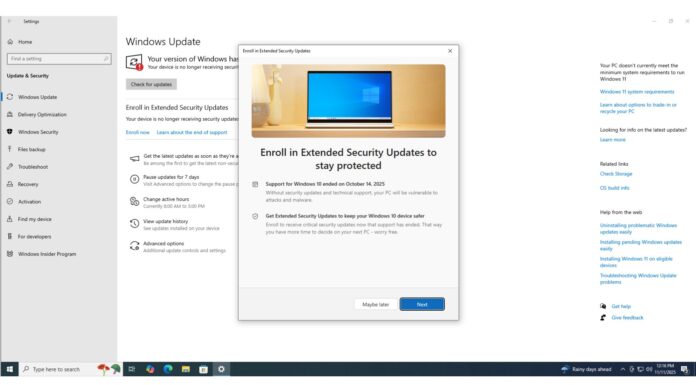Microsoft’s Windows 11 November 2025 update brought with it a couple of nifty fixes that can potentially improve the performance of Windows Gaming Handheld devices, like the ASUS ROG Ally, Lenovo Legion Go, and even the recently launched Xbox Ally X.
In our tests, Windows Latest verified that Windows 11 KB5068861 (OS Builds 26200.7171 and 26100.7171) promises to fix the faster battery drain issues of these handheld devices while they stay in low-power states.
Microsoft also assures that the update fixes the issue where the controllers stop responding in apps for about 5 seconds after you sign in with the built-in Gamepad. Some devices wouldn’t hide the touch keyboard after you type in the PIN or password to sign in. The KB5068861 update now automatically hides the keyboard.
Windows Gaming Handheld devices have notoriously poor battery life
Ever since the Asus ROG Ally launched, which has been more than 2 years now, people have been complaining about its awful battery life. As expected, Windows is the culprit, because, among other things, it ships without removing any of the totally unnecessary apps for a gaming device, like Paint, for example.
Windows 11 for handheld gaming devices is the same Windows that comes with any device, so the capable Ryzen Z1 and Z1 Extreme APUs, along with the 16GB LPDDR5 RAM, ate through the battery.
Naturally, people got used to the one to two-hour battery life of the Ally, but what they couldn’t live with was the poor standby time, especially when the device is in Sleep mode.
It didn’t take them long to realise that it was a Windows issue.
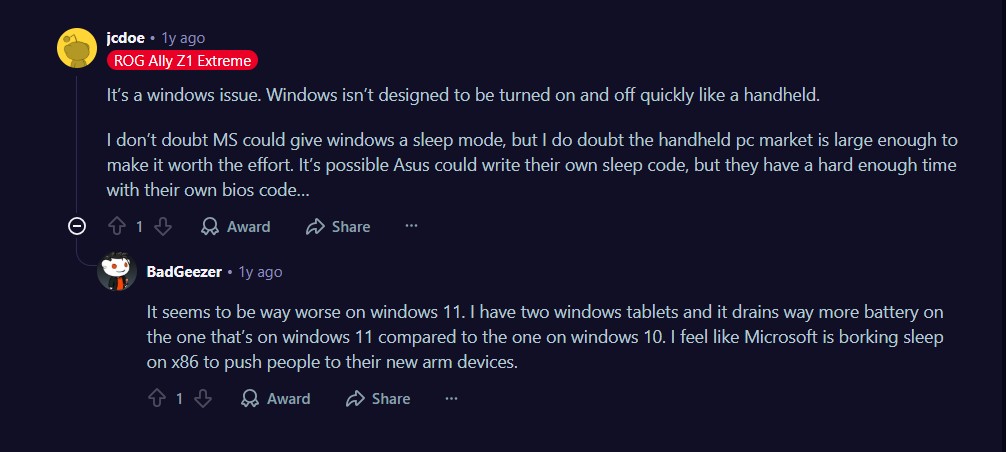
The Lenovo Legion Go and the MSI Claw, both of which launched a few months later, had the same battery and sleep issues.
Many users recommended turning on the Hibernate mode and not the Sleep mode, which has solved the battery drain issue, at least while the devices are not being used.
In Windows 11, Sleep is a low‑power state where your PC remains partially on. It keeps all open applications and documents stored in RAM. So, when you turn it back on, you’ll be able to resume your session almost instantly. As you’d expect, it works best for short intervals.
Since the RAM uses a small amount of power to maintain its contents, your battery will continue to drain slowly, and naturally, if it runs out completely, all unsaved work could be lost.
Hibernate in Windows saves the entire session to your SSD and then powers off the PC. So, technically, there won’t be any battery drain, though resuming from Hibernate takes longer than from Sleep.
That being said, the Sleep mode is what comes on as the default, so battery life in standby isn’t the strong point of Windows gaming handhelds, making them almost unusable while travelling.
Windows gaming handheld devices are popular, regardless of their flaws
But despite these issues, Windows gaming handhelds had seen a strong reception, especially in the US. The ASUS ROG Ally, launched in 2023, sold almost 500,000 units in the first month. The Lenovo Legion Go also had good initial sales as a competitor to the Ally.
However, MSI Claw didn’t perform well, both in sales and in games.
Following the initial hit of the Ally, ASUS launched the ROG Ally X, with double the battery capacity (80Wh, up from 40Wh), 24GB RAM, and 1TB storage. Of course, the highlight was increased battery capacity, especially since there wasn’t an upgrade in the processor.
And there’s no point in guessing why they doubled the battery capacity. The ASUS ROG Ally X went on to become popular in some markets.
Even then, the issue with Windows being unoptimized for handhelds was still something that users found difficult, especially considering that the more than three-year-old Stem Deck is still on a roll. Not to mention the new Nintendo Switch 2, which was launched in June 2025, is selling like hot cakes.
Both these gaming handhelds have their respective operating systems optimized for their form factors. Windows gaming handhelds, despite doing well in the market, didn’t gain the popularity or likability of these optimized devices, and Microsoft had to do something.
Microsoft answers with the Xbox Full Screen Experience
On October 16, 2025, the ASUS ROG Xbox Ally and the Aly X launched with the first appearance of Microsoft’s Xbox Full Screen Experience (FSE) for Windows 11.
With the Xbox tag, people expected the devices to have the same Xbox system software as the gaming consoles. Instead, Microsoft again brought the full Windows 11 OS, but with the addition of Xbox FSE, which negated some of the drawbacks of the full Windows experience.
Reports suggested that the ASUS ROG Xbox Ally with Full Screen Experience ran smoother with better fps than when it ran with the full Windows 11 UI.
This was surprisingly enough for the customers, and as per the latest reports, the ROG Xbox Ally X demand is higher than ASUS expected, with sales for the Ally series expected to be between $96m – $160m this quarter.
Microsoft was in the right when they rolled out the Xbox Full Screen Experience to the MSI Claw as well with the Windows 11 Insider Preview Build 26220.7051, in late October. We expect more handheld devices, like the Legion Go and the ones from AYANEO, to get a similar treatment.
Windows 11 November 2025 update brings more performance improvements to Gaming handhelds
Microsoft understands that the full-fledged Windows 11 experience isn’t ideal for gaming handhelds, which is probably why they launched the Xbox FSE.
Users have installed the Xbox Fullscreen experience in even the as-of-now unsupported Lenovo Legion Go and experienced massive improvements. However, the battery drain issue in Sleep mode still plagues Windows 11.
The Windows 11 November 2025 update allegedly fixes these issues. Microsoft says that the new update finally lets the devices save more power when they sleep. The company hasn’t mentioned how they do this. We suspect that it reduces the power draw from the RAM, considering that the modules in all these handhelds run at extremely high speeds of 6400 MT/s.
Microsoft documented the fix:
“Fixed: This update addresses an issue that affects gaming handheld devices. These devices were unable to stay in low-power states, which caused faster battery drain.
Fixed: This update addresses an issue on some handheld gaming devices where after signing in using the built-in Gamepad, the controller might not respond in apps for about five seconds, causing a delay. After you submit your password or PIN, the touch keyboard on the sign-in screen hides automatically.”
In our tests, the Windows 11 25H2 update works fine on regular Windows PCs. However, several users have had issues with the KB5068861 update not installing on their ROG Ally X.
The update also fixes the irritating five-second delay that showed up after signing in with the built-in gamepad. Apps refused to respond to the joystick soon after you signed in. The touch keyboard isn’t supposed to stay on screen after typing the PIN. Either way, the update removes the delay and hides the keyboard as soon as you sign in.
The November patch update doesn’t seem to have any issues so far, so if you have a Windows gaming handheld, we recommend you install it and see if these issues still persist.




